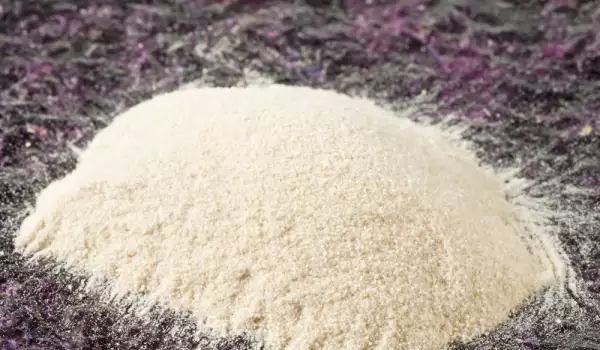Agar-Agar, or simply agar, is a gelling agent - a polysaccharide which is derived from several species of red algae. It is a mixture of polysaccharides and agaropectin agarose, the algae Gelidium, Gracilaria, Geranium and others that grow in the Pacific Ocean and the White Sea.
Translated from Malay, agar-agar means seaweed. Agar-agar and its properties have been well known in Asia for hundreds of years. For various reasons, however, agar did not reach Europe until the late 19th century, and even then failed to muster the necessary strength and speed to become popular.
Selecting and storing agar
Agar can be purchased from specialized and some organic shops. The price varies. After opening the bag, keep the gelling agent in the refrigerator because of the danger of spoilage.

Agar in cooking
Agar-agar is a stabilizer that is used for the maintenance of viscosity and consistency of products. This is a supplement that has been authorized for use in all countries of the world, it is also recognized as the best gelling agent among the currently known pure colloids. The melting temperature of the agar is around 180°F (80 °C). Gels containing agar in their composition, preserve the taste and aroma of the main ingredients.
Agar has no taste, colour and odour. It is used in the food industry for the production of moulded products. It is very widely used in the manufacture of various jams, jellied meats and puddings, ice cream and bonbons, dairy / yogurt and cheese / jelly creams in pastries. In the food industry, agar-agar has been known as the additive E 406.
The use of agar is not complicated. It dissolves in hot or cold water. Soaking itself takes only a few minutes. The proportion of water to agar should be stated on the package. If not described, use 0.03 oz (0.9 g) in 3.5 fl oz (100 ml) of water. Place to boil and then allow it to simmer for 5 minutes if it is powdered, or 10-15 minutes when in the form of flakes.
This is done in order to dissolve the active substances. It may be added to both heated mixtures, but also those that are at room temperature. When the mixture cools, the agar should be hardened.
Agar-agar is an ideal product for gelling. It can be used in creams, replacing the use of eggs.

The difference between agar and gelatine
Unlike gelatine, agar can be safely used by vegetarians, vegans, or people on a special diet because it is derived from seaweed. Agar hardens faster and stronger than gelatine. It is ready when the mixture has cooled and is 10 times more effective than gelatine.
It is not necessary to put it in the refrigerator. Agar hardens even at room temperature. It stands in the form of a gel even at elevated temperatures. This gives it an incredible advantage to be served in hot meals. It melts at 180°F (80 °C).
Agar gel is thermoreversible, which means that you can boil it, let it harden and then boil again without problem. It gives a feeling of satiety after ingestion because its volume expands.
The amount of agar powder and that of gelatin are not interchangeable. The difference lies in the ratio of the astringent and water / liquid. With the same amount of gelatine / agar-agar achieves different level of hardening, but agar gelling prevails.

Mixtures with agar should not be placed in containers, where there is oil or other fat, because it will interfere with the process of solidifying. It is for this same reason you do not use foil.
When using agar in mixtures with acidic fruit / such as strawberries and citrus / it is desirable to use a larger quantity in order to achieve a better effect.
Enzymes in kiwi and pineapple, fresh figs, mango, papaya and peaches violate the gelling properties of agar-agar. It is therefore recommended to boil before adding them. Other products which influence gelation are chocolate and spinach.
Benefits of agar
It is believed that this gelling agent helps to reduce levels of bad cholesterol, has no calories, purifies the body, and is composed of about 80% fiber. It helps the process of digestion and prevents intestinal mucus and positively affects constipation because of its laxative agent.
Agar-agar is a useful source of salts and minerals for the human body. It is believed that agar relieves the body of toxins and harmful deposits and normalizes the functioning of the liver and helps in metabolism.
There is no maximum tolerated dose. In some countries, E 406 is also approved for use in baby and medical foods.











Comments